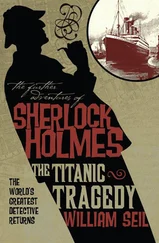Social, rather than evolutionary, order must be maintained in a shipwreck: the fittest are obliged to ensure the survival of the weakest. Two days after the Titanic went down, the St Louis Post-Dispatch put the dilemma for male passengers in the form of an illustration entitled ‘The Last Seat — Should He Take It?’ A handsome young bridegroom is poised on a ladder between a sinking ship and a departing lifeboat, his lovely wife stands in the lifeboat with her arms open wide; behind him on the ladder is an unknown damsel in distress. There is only one seat in the boat: should the bridegroom preserve the family and join his wife, or be chivalric and make his wife a widow? Ismay, who had no relatives on board the ship to whom he could display his courage, showed neither the manners of a gentleman nor the mettle of a man; like Lady Macbeth, he was unsexed by his crime.
It is easy to become what Second Officer Lightoller called an ‘armchair judge’, and forget that the Titanic passengers were responding to the crisis moment by moment. People behaved instinctively, but instincts need to be trained. Any number of brave and extraordinary acts took place as fear set in, couples separated and people prepared to die, but Ismay was seen to perform none of them. He had one view only: to carry on living. His instinct to survive became a force which overwhelmed and obliterated a lifetime of training. Of the few passengers who publicly praised his behaviour, three were women. The first was a stewardess who said that Ismay had saved her life by insisting that, being a ‘woman’ as well as a stewardess, she climb into a lifeboat; the second was Edith Russell, the fashion reporter who had likened the ship going down to a skyscraper. Miss Russell told the New York Times that as one of the last boats was being lowered, Ismay seized her arm and said: ‘Woman, what are you doing here? All women should be off the boat.’ Having been told by an officer that there was ‘no immediate danger’ and that the Titanic ’s sister, the Olympic, was on her way to pick up the remaining passengers, Edith Russell had been drifting calmly between the lounge and the boat deck cradling her ‘lucky pig’. Had Ismay not thrown her down the steps to A Deck, where she was shoved headfirst, in her hobble skirt and diamond-buckled slippers, through a porthole and into a lifeboat, she would doubtless have stayed on board. ‘There has been much criticism of Mr Ismay,’ said Miss Russell, who claimed that they had subsequently become lovers, ‘but he certainly saved my life.’ The third woman to defend Ismay was Mrs Marian Thayer, who let the press know that any unfair statements about him which had appeared in the papers under her name had not been authorised: ‘Mr Ismay had done everything a man could do to help passengers on the Titanic! And Mrs Thayer did everything she could to defend Mr Ismay, who had — although she did not yet know it — fallen in love with her during the voyage.
J. Bruce Ismay died on the night of 14–15 April 1912, and died again in his bedroom twenty-five years later. He was mired in the moment of his jump; his life was defined by a decision he made in an instant. Other survivors of the Titanic were able, in varying degrees, to pick themselves up and move on, but Ismay was not. His was now a posthumous existence.
It is typical that in his most significant gesture Ismay is poised iconically between a sinking ship and a collapsible boat. The threshold was his natural home. He lived his life between the Old World and the New; when he was in New York, he referred to England as ‘the other side’. He crossed the North Atlantic more than eighty times: he held the record number of crossings between England and America, spending the equivalent of two and a half years floating between ports. Whether dining with the doctor on board as though he were an honorary member of the crew, or sitting stiffly amongst the Lebanese women and children in the lifeboat as though he were a passenger, Ismay is always awkwardly positioned, in neither one place nor another. He is never at the centre of his own story. We watch him skulk around the margins of films like A Night to Remember and James Cameron’s Titanic, the image of wealth, weakness and self-interest, an almost sickly figure separated from the healthy fellowship of potential heroes, an idler amongst workers who gets in everyone’s way when he is only trying to help. In contrast with the image of the stalwart crew, the back-slapping young men and the blue-blooded passengers, Ismay is portrayed as introverted, impotent, nouveau riche. He is the man who doesn’t understand the jokes and can’t keep up with the conversation; in Cameron’s Titanic, where he is played by Jonathan Hyde, Ismay is asked whether it was he who thought of the ship’s name.
‘Yes, actually,’ Ismay replies. ‘I want to convey sheer size; and size means stability, luxury and, above all, strength.’
‘Do you know of Dr Freud, Mr Ismay?’ says Rose De Witt Bukater. ‘His ideas about the male preoccupation with size might be of particular interest to you.’
‘Freud?’ says Ismay. ‘Who is he? A passenger?’
Even before the Titanic, Ismay was despised in America for inheriting rather than earning his position in the White Star Line. To a country of self-made men, he was a spoilt product of the class system. He was despised in Britain, on the other hand, for his lack of pedigree, for assuming the privileges of an aristocrat while working in trade for a living. For a country whose hierarchy is based on birth, Ismay was no more than a Liverpudlian businessman. Seamen thought him a shore-dweller; to his family, who feared him, he was king of an ocean world. Ismay’s problem, as the British inquiry concluded, was that he belonged in a category of his own. He fitted in nowhere, least of all on board the Titanic where, when the crisis came, he slipped through the all-important classifications. Alone of those on board, his journey did not have a destination. Other passengers were going somewhere, most of them on a one-way ticket: emigrating, joining their families, getting married, returning home. But Ismay was drifting across the Atlantic simply to drift back again when the Titanic turned around.
When it came to saving his own life, he later told journalists: ‘I took my chance to escape — yes. It came to me though, I did not seek it… And why shouldn’t I take my turn? There are only two classes on a ship — crew and passengers. I was a passenger. It is true I am president of the company, but where do you draw the line?’ 16Because he was a ‘passenger’ and not a member of the crew, Ismay said that he had ‘nothing to do with’ ordering the loading of the boats. But in a private account of his own experience, Karl H. Behr, a twenty-six-year-old love-sick tennis player who, having secretly pursued his sweetheart, Helen Newsome, across Europe where she was travelling with her parents, had planned an ‘accidental’ meeting with her on board the Titanic, described how Ismay commanded the lowering of the lifeboats as though he were the most authoritative person on the ship. Behr was standing with Miss Newsome and her mother and stepfather, Mr and Mrs Beckwith, next to a ‘comfortably filled’ lifeboat, when ‘Ismay came over to us and calmly told us we should get into a second boat which was being filled’. No one obeyed him as he walked off, because they did not believe that the boat was capable of sinking. ‘In a few minutes Ismay noticed us still standing together; he again walked over and with considerably more emphasis told us to get into the lifeboat — we were the last passengers on the deck. I told Mrs Beckwith I thought we should do what he said, and she finally led the way to the boat. Stepping in front of Ismay, she asked if all her party could get into the same lifeboat and he replied, “Of course Madam, every one of you”.’ 17
Читать дальше












